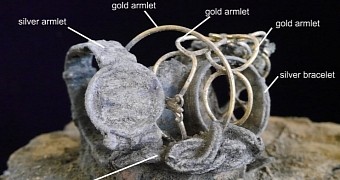While exploring the underbelly of a store in the UK, history enthusiasts with the Colchester Archaeological Trust came across a buried treasure estimated to be about 2,000 years old.
More precisely, they found jewelry and money that they say date back to Roman times. The treasure was found under a Williams & Griffin department store in the town of Colchester.
Looking not to damage the jewelry and the coins, the archaeologists pulled them from the ground in a solid block of soil. They are just now cleaning the dirt off them and studying them in detail, Live Science informs.
Although the pieces still have soil on them, specialists have managed to identify 3 gold armlets and a silver one, a silver necklace, 2 silver bracelets, a box containing 4 rings, and 2 pairs of earrings. The coins all sit in a small bag.
It is expected that, as more dirt is cleaned off the treasure, more pieces of jewelry will be identified. The treasure is now kept in a secure conservation laboratory, and experts are busy removing the dirt covering it with as much care as possible.
This is yet to be confirmed, but the Colchester Archaeological Trust specialists who found this treasure suspect that the jewelry and the money belonged to a wealthy Roman woman who buried them during a riot that occurred around A.D. 61.
At that time, folks native to the region rebelled against the Roman occupation, and burned down homes and other buildings in the area. What's more, they killed several Romans. Since the woman never returned to recover the treasure, it is possible that she too was killed during this riot.
“We think that we have found the jewellery collection of a wealthy Roman woman who lived in Colchester, which had been buried under the floor of a house that was subsequently burnt to the ground during the Boudican Revolt in AD 61,” the researchers say.
“It seems likely that the owner or perhaps one of her slaves buried the jewellery inside her house for safe-keeping during the early stages of the Boudican Revolt, when prospects looked bleak,” the Colchester Archaeological Trust experts go on to explain.
Interestingly enough, human bones displaying signs of sword injuries were also pulled from the ground not far from the place where the treasure was discovered. These bones stand as proof of the violence of the revolt during which the owner of the jewelry and the coins probably lost her life.
Once specialists are done studying it, the treasure will be donated to the Colchester and Ipswich Museum Service, and will likely be put on display.

 14 DAY TRIAL //
14 DAY TRIAL //